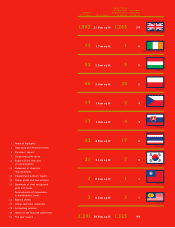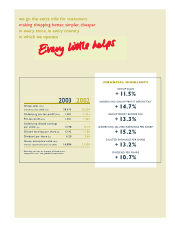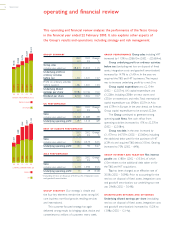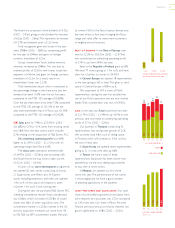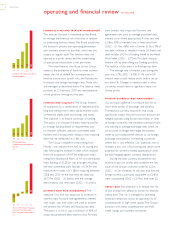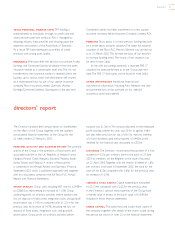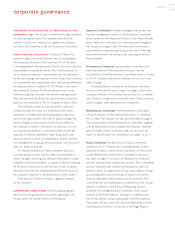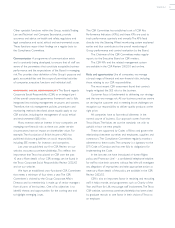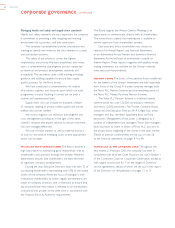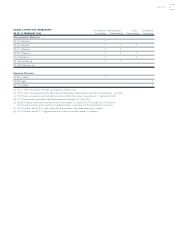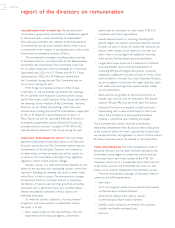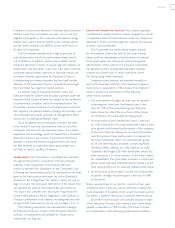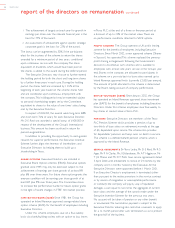Tesco 2003 Annual Report Download - page 10
Download and view the complete annual report
Please find page 10 of the 2003 Tesco annual report below. You can navigate through the pages in the report by either clicking on the pages listed below, or by using the keyword search tool below to find specific information within the annual report.
8TESCO PLC
Compliance Committee The Compliance Committee ensures
that the Board discharges its obligations to comply with all
necessary laws and regulations. It has established a schedule
for the regular review of the Group’s operational activities
to ensure compliance with accepted practices and policies.
The Committee, comprising two Executive Directors and
three members of senior management, normally meets four
times a year.
INTERNAL CONTROL AND RISK MANAGEMENT The Board
has overall responsibility for internal control, including risk
management, and sets appropriate policies having regard to
the objectives of the Group. Executive management has the
responsibility for the identification, evaluation and management
of financial and non-financial risks and for the implementation
and maintenance of control systems in accordance with the
Board’s policies.
The Board, through the Audit Committee, has reviewed
the effectiveness of the systems of internal control for the
accounting year and the period to the date of approval of
the financial statements, although it should be understood
that such systems are designed to provide reasonable but
not absolute assurance against material misstatement or loss.
Internal control environment The Group operates an
objectives-driven approach aimed at satisfying its core
purpose that translates into a rolling five-year business plan.
The plan covers both revenue and capital expenditure and
forms the basis of business plans for all our business entities.
From this the Board, together with monitoring regimes based
upon our Steering Wheel, agrees the annual revenue and
capital budgets.
The Steering Wheel is the term used to describe our
balanced scorecard approach, which we believe is the best
way to achieve results for our shareholders. It sets out a
broad range of targets under quadrant headings of customers,
operations, people and finance.This allows the business to be
operated and monitored on a balanced basis with due regard
for all stakeholders. The Board undertakes a formal review
of progress on a quarterly basis and any resulting actions
considered appropriate are communicated throughout
the business.
The capital investment programme is subject to formalised
review procedures requiring key criteria to be met. All major
initiatives require business cases to be prepared, normally
covering a minimum period of five years. Post-investment
appraisals are also carried out.
Risk management process At the highest level, the Board
considers strategic risk every time it meets. The two-day
Board Conference, referred to earlier, considers where future
opportunities and risks lie and helps shape our corporate
strategy going forward. Accountabilities for managing
operational risks are clearly assigned to line management.
Internal controls have been developed over all risks in line
with the risk appetite determined by the Board and are
subject to review. Formal risk assessments are carried out
routinely throughout the business. Procedures exist to ensure
that significant risks and control failures are escalated to
senior management and the Board, as necessary, on a daily,
weekly and periodic basis.
Monitoring The monitoring of strategic and operational
risks are responsibilities of the Board and line managers
respectively.
The Board maintains the Key Risk Register and considers
at their formal risk assessments whether the actions being
taken in mitigation are sufficient.
The Internal Audit function also operates on a risk-based
approach helping managers with their risk responsibilities and
advising on appropriate controls.
PricewaterhouseCoopers LLP, our external auditors,
contribute a further independent perspective on certain
aspects of the internal financial control system arising from
their work. Independence is strengthened by an agreement
to rotate audit partners every five years.The engagement
of auditors is considered annually by the Audit Committee.
Annual statements received from CEOs further support
the monitoring of key subsidiary operations.These statements
confirm that the Board’s governance policies have been
adopted in practice and spirit.
Overall, the Audit Committee seeks to ensure that
the whole management process provides adequate control
over all major risks to the Group.This is achieved through
consideration of regular reports from internal and external
audit alongside discussions with senior managers.
corporate governance continued


